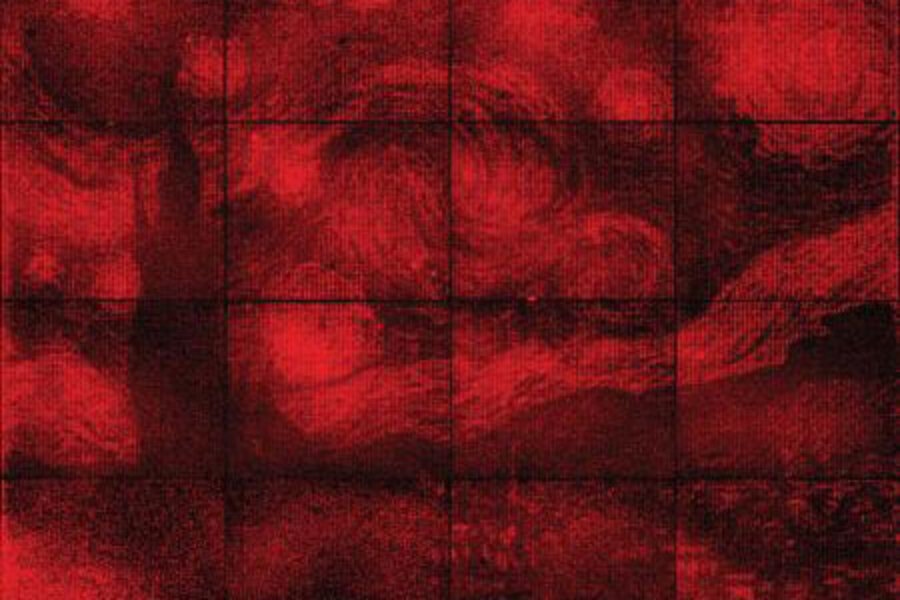DNA origami rendition of 'Starry Night': Why does it matter?
Loading...
Art plays an important, sometimes central, role in many human cultures. You could even say it’s in our DNA.
At the intersection of art and science, researchers from the California Institute of Technology recreated Vincent Van Gogh’s ‘Starry Night’ using folded DNA. This fluorescent rendition of the famous work, described Monday in the journal Nature, was made possible by ‘DNA origami’ – a technique that could someday power quantum computers.
DNA origami is the process of folding and manipulating long strands of DNA. By combining these folded strands into a latticed network, scientists can create a kind of “pegboard” to organize extremely small molecules. Paul Rothemund, a research professor at Caltech, developed the technique in 2006.
"It all happens in a test tube without human intervention,” Dr. Rothemund said in a press release, “which is important because all of the parts are too small to manipulate efficiently, and we want to make billions of devices."
The next step was to link these nanoscopic devices together. Early attempts consisted mostly of “spray and pray” – researchers would scatter the material on a surface in hopes that some pieces would land in the right spot. In 2009, Rothemund’s team described a new technique that used focused electron beams to carve custom binding sites into surfaces. From there, each folded DNA strand would fit neatly into its corresponding slot.
“It’s not easy to manipulate certain molecules,” lead author Ashwin Gopinath says in an interview with The Christian Science Monitor. “But you can stick it to something big, and if you know it’s connected to this huge thing, you won’t lose it. The beauty of [DNA] origami is that it’s big enough to produce scalably, but within the origami you can identify every single point.”
Rothemund and colleagues’ recreation of "Starry Night" is the first application of this technology. As a kind of proof-of-concept, researchers mapped out a checkerboard pattern using DNA origami and filled them with photonic crystal cavities (PCCs). These nanostructures trap certain wavelengths of light – the size and shape of each cavity corresponds to different colors and brightnesses. So by carefully selecting and integrating different DNA folds and PCC shapes, Dr. Gopinath and colleagues were able to create a hot-and-cold monochrome copy of Van Gogh’s most famous painting.
The end result is both aesthetically and structurally impressive. Deeper still, researchers say their device represents another step toward a fully-functioning quantum computer.
Academic and military institutions have aggressively researched quantum computers, which use quantum-mechanical phenomena to process data. These devices would be able to comb through unfathomable amounts of data in significantly less time than current technology allows, aiding government agencies in message decryption and allowing scientists to conduct virtual experiments. Of course, existing quantum computers don’t operate at full capacity, nor can they be mass-produced.
One method of quantum computing, called linear optical quantum computing (LOQC), is powered by a network of tiny light sources called emitters. Each emitter must produce exactly one photon at a time, and each must be identical to the others, and it must be able to do so at very well-defined time intervals.
There are many barriers to this paradigm. An ideal light source has yet to be developed, and LOQC circuits must be built one at a time. But new research could solve the problem of efficient production.
“Currently, we don’t have techniques to place single emitters exactly where we want to,” Gopinath says. “If we had an ideal light source, this technique could put it scalably where we want.”
In other words, while DNA origami can’t produce viable quantum emitters, it could potentially organize them. Until then, Gopinath and colleagues will seek new experimental emitters and ways to control their direction. But quantum computing is a complex and contentious field, and Gopinath is quick to make note of that.
“There are other competing approaches to quantum computing, and everyone says theirs is the best,” Gopinath laughs. “I’m not even going to go there and say that mine is the best.”








